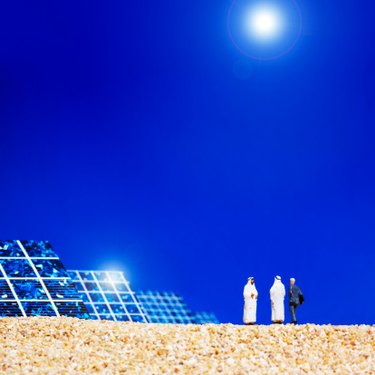How to Calculate Energy Per Acre for Solar Panels

The sun provides a huge amount of energy as its rays touch the Earth’s surface. But the quantity of energy that you can harness is another matter. The efficiency of solar cells, their arrangement, and the amount of sunlight they receive all affect their output. Before deciding whether solar panels are a good choice to save you money, determine if you can fully power your home with solar panel electricity.
Step 1
Determine your solar panels’ efficiency rate. The amount of energy that can be taken in and converted into electrical energy per solar panel is its efficiency. For photovoltaic solar cells, efficiency can reach about 19 percent. But for concentrated photovoltaic cell panels or CPV panels, the efficiency can exceed 40 percent. Whether you are creating your own panels or purchasing pre-made panels, determine the efficiency per cell of the panels you plan to install. Keep in mind when choosing what type of panels to use that CPV panels usually require more work to set up, and more land, as they are designed to concentrate sunlight on a specific panel.
Step 2
Size the area for your solar panels. Determine how many panels can fit on your designated area while taking into account the terrain, local construction laws, and other spacing issues. Solar panels come in several types and dimensions but, as an example, 100-200W solar panels usually measure 1 square meter in size.
Step 3
Calculate the energy per acre. On average, 1 square meter of solar panels directly exposed to sunlight will receive about 1-kilowatt hour (kW/h) of energy per hour for the six hours it is exposed to effective sunlight, or 6-kilowatt hours of solar energy a day. One acre is approximately 4,046 square meters, so if you have an acre’s worth of solar cells, then you will receive about 4,046 kilowatt hours of electricity each hour, or 24,276-kilowatt hours a day.
Step 4
Multiply the energy you receive by the efficiency of your solar panels to discover how much usable electricity you can yield. If your solar panels are 19 percent efficient and you receive 24,276 kilowatt hours a day of solar energy, then you will receive about 4,612-kilowatt hours of usable electricity through solar energy.
Step 5
Subtract your maximum potential energy needs from the amount of energy being produced. You can find out how much energy you use by looking at a past electric bill or calling up the company that services your electricity directly. But for a general idea, the average American family uses about 920-kilowatt hours of electricity per month. So if you produced approximately 4,612-kilowatt hours of usable electricity per day, you would produce enough energy in a day to run four average households for a month.
